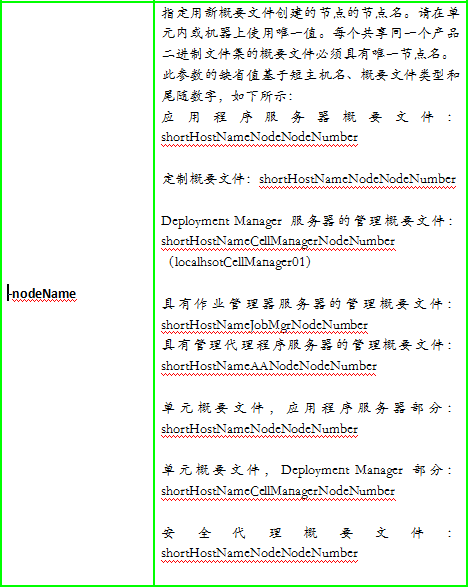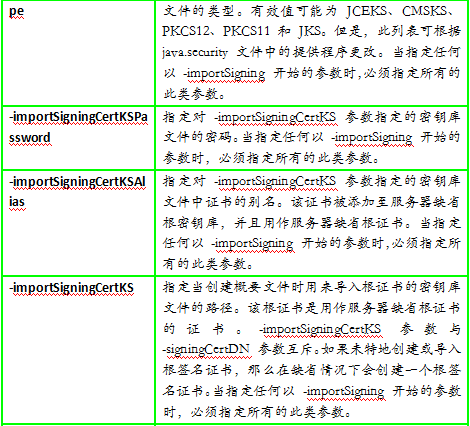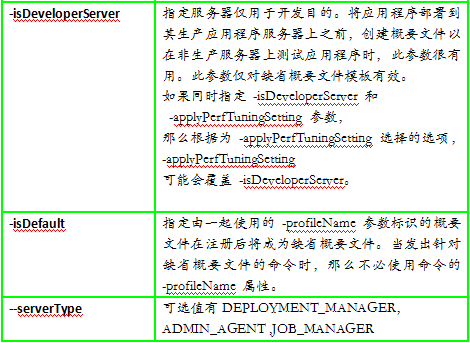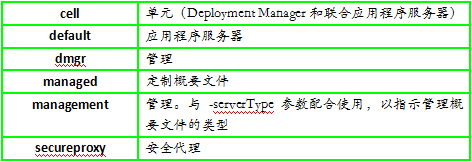使用命令管理概要文件
Posted
tags:
篇首语:本文由小常识网(cha138.com)小编为大家整理,主要介绍了使用命令管理概要文件相关的知识,希望对你有一定的参考价值。
使用命令管理概要文件
概要管理工具的核心是manageprofiles命令,这个命令提供了对概要进行普通的维护活动的方法。可以调用这个命令创建(采用本机方式或静默方式)、列出、删除概要,验证概要注册中心,和完成其他功能。
(一)manageprofiles命令使用语法介绍
Manageprofiles.sh —模式 —参数
Manageprofiles命令的模式有:
Manageprofiles命令的参数有:
(二)创建概要文件可用的模板
注意:dmgr模板已经过时,建议使用management 模板创建管理概要文件。
(三)创建各个类型的概要文件常用的参数
1.创建DM的profile(dmgr)
使用的模版在install_root/profileTemplates/dmgr下
句法为:
manageprofile.sh -create -templatePath install_root/profileTemplates/dmgr
调用参数为:
-create 建立一个profile. (必选)
-templatePath 指定使用模版的路径. (必选)
建立DM的路径为install_root/profileTemplates/dmgr
-profileName 指定profile的名字. (可选)
-profilePath 指定proflile需要建立的路径. (可选)
-hostName 指定profile对应的主机名称. (可选)
-nodeName 指定profile对应的node的名称.
此名称必须在同一cell中唯一. (可选)
-cellName 指定profile对应的cell的名称.
每一个profile的cell名称必须唯一. (可选)
-isDefault 将此profile指定为缺省的profile,
在运行命令期间不需要使用profileName的参数. (可选)
-omitAction 附加条件. (可选)
-adminUserName 在指定administrative security选项后的管理员名称. (可选)
-adminPassword 在指定administrative security选项后的管理员密码. (可选)
-portsFile 指定profile的端口设定文件.
此参数和-startingPort或-defaultPorts参数冲突. (可选)
-startingPort 制度建立profile是的所有的端口的起始的端口号.
同-portsFile或者-defaultPorts参数冲突. (可选)
-defaultPorts 对新建立的profile使用缺省的端口号.
同-portsFile 或 -startingPort 参数冲突. (可选)
-validatePorts 进行端口号验证,保证使用的端口号没有已经被用
或者被保留. (可选)
-enableAdminSecurity 新建立的profile使用用户密码方式认证,
使用此参数后面跟 true. (可选)
-enableService 作为linux的service使用,使用此参数后面跟 true. (可选)
-serviceUserName 指定作为service使用时的用户. (可选)
例子: 使用概要管理工具创建的管理概要文件
managerprofiles.sh -create
-templatePath /opt/IBM/WebSphere/AppServer/profileTemplates/dmgr
-profilePath /opt/IBM/Websphere/AppServer/profiles/Dmgr01
-profileName Dmgr01 -nodeName localhostCellManager01
-hostName localhost -cellName localhostCell01
-enableAdminSecurity true -adminUserName admin -adminPassword admin
由于dmgr模板已经过时,使用management模板代替dmgr模板创建管理概要文件。
managerprofiles.sh -create
-templatePath /opt/IBM/WebSphere/AppServer/profileTemplates/management
-serverType DEPLOYMENT_MANAGER
-profilePath /opt/IBM/Websphere/AppServer/profiles/Dmgr01
-profileName Dmgr01 -nodeName localhostCellManager01
-hostName localhost -cellName localhostCell01
-enableAdminSecurity true -adminUserName admin -adminPassword admin
2.建立cell的profile(Cell)
其中包含了DM和APP SERVER,
使用的模版在install_root/profileTemplates/cell/dmgr(default)
句法为:
manageprofile.sh -create -templatePath install_root/profileTemplates/cell/dmgr
-nodeProfilePath install_root/profiles/AppSrv01 -cellName cell01dmgr -nodeName
node01dmgr -appServerNodeName node01
manageprofile.sh -create -templatePath install_root/profileTemplates/cell/default
-dmgrProfilePath install_root/profiles/Dmgr01
-portsFile install_root/profiles/Dmgr01/properties/portdef.props
-nodePortsFile install_root/profiles/Dmgr01/properties/nodeportdef.props
-cellName cell01dmgr -nodeName node01dmgr -appServerNodeName node01
调用参数为:
-create 建立一个profile. (必选)
-templatePath 指定使用模版的路径. (必选) 建立DN和APP的路径为
install_root/profileTemplates/cell/dmgr(default)
建立dm部分的参数:
-profileName 指定profile的名字. 参数可选但是如没有赋值,会使用缺省值.
-nodeProfilePath 指定proflile需要建立的node的路径. 参数可选但是如没有赋
值,会使用缺省值.
-hostName 指定profile对应的主机名称.(可选)
-nodeName 指定profile对应的node的名称.
此名称必须在同一cell中唯一. (可选)
-cellName 指定profile对应的cell的名称.
每一个profile的cell名称必须唯一. (可选)
-appServerNodeName 指定app所在cell中node的名称. 参数可选但是如没有赋值,
会使用缺省值.
-enableAdminSecurity 新建立的profile使用用户密码方式认证,使用此参数后面跟
true. (可选)
-enableService 作为linux的service使用,使用此参数后面跟 true. (可选)
-webServerCheck 建立一个Web server的定义.指定值为true. (可选)
-webServerName 指定建立的Web Server的名称. (可选)
-webServerHostname 指定Web Server的主机名称. (可选)
-webServerPort 指定Web server运行的端口. (可选)
-webServerInstallPath 指定Web server的安装路径. (可选)
-webServerPluginPath 指定Web server插件的安装路径.(可选)
-isDefault 讲此profile指定为缺省的profile,在运行命令期间不需要使用
profileName的参数. (可选)
-omitAction 附加条件. (可选)
-adminUserName 在指定administrative security选项后的管理员名称. (可选)
-adminPassword 在指定administrative security选项后的管理员密码. (可选)
-portsFile 指定profile的端口设定文件. 此参数和-startingPort或
-defaultPorts参数冲突. (可选)
-startingPort 制度建立profile是的所有的端口的起始的端口号.
同-portsFile或者-defaultPorts参数冲突. (可选)
-defaultPorts 对新建立的profile使用缺省的端口号.
同-portsFile 或 -startingPort 参数冲突. (可选)
-validatePorts 进行端口号验证,保证使用的端口号没有已经被用或者被
保留. (可选)
-nodePortsFile 指定node使用端口设定的文件,同-nodeStartingPort或者
-nodeDefaultPorts参数冲突. (可选)
-nodeStartingPort 指定所有的结点端口的起始的端口号. 同-nodePortsFile或
者-nodeDefaultPorts参数冲突. (可选)
-nodeDefaultPorts 对结点使用缺省的端口号.同-nodePortsFile或者
-nodeStartingPort参数冲突. (可选)
-serviceUserName 指定作为service使用时的用户. (可选)
-webServerType 指定Web server的类型. (可选)
-webServerOS 指定Web server的操作系统的类型. (可选)
建立app部分的参数:
-profileName 指定profile的名字. 参数可选但是如没有赋值,会使用缺省值.
-profilePath 指定proflile需要建立的路径. 参数可选但是如没有赋值,
会使用缺省值.
-hostName 指定profile对应的主机名称.(可选)
-nodeName 指定profile对应的node的名称. 此名称必须在同一cell中唯
一. (可选)
-cellName 指定profile对应的cell的名称. 每一个profile的cell名称
必须唯一. (可选)
-appServerNodeName 指定app server的结点名称. (可选)
-enableAdminSecurity 新建立的profile使用用户密码方式认证,使用此参数后面跟
true. (可选)
-isDefault 讲此profile指定为缺省的profile,在运行命令期间不需要使用
profileName的参数. (可选)
-omitAction 附加条件. (可选)
-adminUserName 在指定administrative security选项后的管理员名称. (可选)
-adminPassword 在指定administrative security选项后的管理员密码. (可选)
-portsFile 指定profile的端口设定文件. 此参数和-startingPort或
-defaultPorts参数冲突. (可选)
-startingPort 指定建立profile是的所有的端口的起始的端口号.
同-portsFile或者-defaultPorts参数冲突. (可选)
-defaultPorts 对新建立的profile使用缺省的端口号.
同-portsFile 或 -startingPort 参数冲突. (可选)
-validatePorts 进行端口号验证,保证使用的端口号没有已经被用或者被保
留. (可选)
-nodePortsFile 指定node使用端口设定的文件,同-nodeStartingPort或者
-nodeDefaultPorts参数冲突. (可选)
-nodeStartingPort 指定所有的结点端口的起始的端口号. 同-nodePortsFile或者
-nodeDefaultPorts参数冲突. (可选)
-nodeDefaultPorts 对结点使用缺省的端口号.同-nodePortsFile或者
-nodeStartingPort参数冲突. (可选)
例子:
manageprofiles.sh -create \
-templatePath $WAS_HOME/profileTemplates/cell/dmgr \
-profilePath $PRO_HOME/Dmgr01 \
-nodeProfilePath $PRO_HOME/AppSrv01 \
-cellName ecds01 \
-profileName Dmgr01 \
-appServerNodeName ecdsPrd01 \
-nodeName ecdsMng01 \
-enableAdminSecurity true \
-adminUserName wasadmin \
-adminPassword password
manageprofiles.sh -create \
-templatePath $WAS_HOME/profileTemplates/cell/default \
-profilePath $PRO_HOME/AppSrv01 \
-dmgrProfilePath $PRO_HOME/Dmgr01 \
-cellName ecds01 \
-profileName AppSrv01 \
-enableAdminSecurity true \
-adminUserName wasadmin \
-adminPassword password \
-appServerNodeName ecdsPrd01 \
-nodeName ecdsMng01
3.建立appsrv的profile(default)
使用的模版在install_root/profileTemplates/default
句法为:
manageprofile.sh -create -templatePath
install_root/profileTemplates/default
调用参数为:
-create 建立一个profile. (必选)
-templatePath 指定使用模版的路径. (必选) 建立APP的路径为
install_root/profileTemplates/default
-profileName 指定profile的名字. 参数可选但是如没有赋值,会使
用缺省值.
-profilePath 指定proflile需要建立的路径. 参数可选但是如没有
赋值,会使用缺省值.
-hostName 指定profile对应的主机名称.(可选)
-nodeName 指定profile对应的node的名称. 此名称必须在同一
cell中唯一. (可选)
-cellName 指定profile对应的cell的名称. 每一个profile的cell
名称必须唯一. (可选)
-enableAdminSecurity 新建立的profile使用用户密码方式认证,使用此参
数后面跟 true. (可选)
-enableService 作为linux的service使用,使用此参数后面跟
true.(可选) 以上是关于使用命令管理概要文件的主要内容,如果未能解决你的问题,请参考以下文章
-webServerCheck 建立一个Web server的定义.指定值为true. (可选)
-webServerName 指定建立的Web Server的名称. (可选)
-webServerHostname 指定Web Server的主机名称. (可选)
-webServerPort 指定Web server运行的端口. (可选)
-webServerInstallPath 指定Web server的安装路径. (可选)
-webServerPluginPath 指








